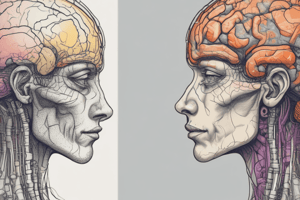Podcast
Questions and Answers
What type of vessel is most vulnerable to traumatic injury in an epidural hematoma?
What type of vessel is most vulnerable to traumatic injury in an epidural hematoma?
- Dural sinuses
- Middle meningeal artery (correct)
- Cerebral arteries
- Bridging veins
In which age group can a dural vessel tear occur even without a skull fracture?
In which age group can a dural vessel tear occur even without a skull fracture?
- Children
- Elderly
- Infants (correct)
- Adults
What typically occurs several hours after a traumatic event causing an epidural hematoma?
What typically occurs several hours after a traumatic event causing an epidural hematoma?
- Immediate neurologic signs appear
- No symptoms appear
- The hematoma resolves on its own
- Patients can be lucid (correct)
Which condition necessitates prompt drainage and repair to prevent death?
Which condition necessitates prompt drainage and repair to prevent death?
Where are subdural hematomas most commonly located?
Where are subdural hematomas most commonly located?
What causes the neurologic signs in subdural hematomas?
What causes the neurologic signs in subdural hematomas?
How long after an injury do subdural hematomas typically become manifest?
How long after an injury do subdural hematomas typically become manifest?
What characteristic describes an acute subdural hematoma?
What characteristic describes an acute subdural hematoma?
What type of brain injury is characterized by the involvement of frontal lobe regions, often without external signs of head injury?
What type of brain injury is characterized by the involvement of frontal lobe regions, often without external signs of head injury?
What happens when the brain is impacted at a site opposite the point of impact?
What happens when the brain is impacted at a site opposite the point of impact?
Why are contusions more common in the orbitofrontal and temporal lobe regions?
Why are contusions more common in the orbitofrontal and temporal lobe regions?
What morphological characteristic is typical of old traumatic lesions in the brain?
What morphological characteristic is typical of old traumatic lesions in the brain?
What kind of hemorrhages can CNS trauma cause?
What kind of hemorrhages can CNS trauma cause?
Which factor does NOT influence the outcome of brain and spinal cord trauma?
Which factor does NOT influence the outcome of brain and spinal cord trauma?
Which scenario correctly demonstrates a coup injury?
Which scenario correctly demonstrates a coup injury?
Flashcards are hidden until you start studying




